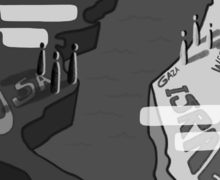SU professor researches, produces Restoration Shakespeare
Corey Henry | Photo Editor
SU professor Amanda Eubanks Winkler, co-investigator for the Performing Restoration Shakespeare project.
When she was a graduate student at the University of Michigan, Amanda Eubanks Winkler studied microfilms at the request of an adviser. Eubanks Winkler said she was fascinated by what she found — music from a 17th century restoration production of Macbeth featuring singing and dancing witches. She said the witches sounded jolly, rather than dissonant, and this intrigued her.
Now, Eubanks Winkler, an associate professor of music history and cultures at Syracuse University, is the international co-investigator of the Performing Restoration Shakespeare project, which stages adaptations of Shakespeare from the Restoration period. As part of the project, she incorporated the singing witches music from the microfilm into a performance of Macbeth at the Folger Theatre in 2018.
Eubanks Winkler works with Richard Schoch, a professor of drama at Queen’s University Belfast and the principal investigator of the project. The research project, which is funded by the Arts and Humanities Research Council, involves collaboration between artists and scholars and focuses on staging Restoration adaptations of Shakespeare’s works. The project’s partners include the Folger Shakespeare Library and Shakespeare’s Globe.
This past July, Performing Restoration Shakespeare presented a showcase at the Globe Theatre in London. The showcase featured reprises of past performances of Macbeth and The Tempest, a discussion session and an audience Q&A.
Shakespeare as we know him in performance has been a product of adaptation from almost the very beginning.Kathleen Lynch, the director of the Folger Institute
Performing Restoration Shakespeare also produced a series of six documentary videos about their 2018 production of a Restoration adaptation of Macbeth at the Folger Theatre. The final four installments of these documentary videos were released two weeks ago, and all of them are available on Performing Restoration Shakespeare’s YouTube channel.
The Restoration period is the time between 1660 and 1714, when the theaters reopened after being closed for almost 20 years. According to Schoch, this time period is characterized by “a great sense of freedom.”
“They were determined to do everything they could to make theater a kind of wondrous, spectacular, enchanting experience for audiences that had been denied theater for nearly two decades,” Schoch said.
Restoration productions included music, dancing and extravagant scenery, according to Schoch. Actresses replaced the actors who had previously performed the parts of women characters.
Eubanks Winkler said that many themes presented in Restoration drama are relevant to us today, noting how many Restoration works deal with gender hierarchies, religious strife and divided political systems.
“I think that people who would read Restoration drama or see it performed would find a lot of really interesting analogies between their time and our time, because they were really interested in some of the same questions as we are today,” Eubanks Winkler said.
Eubanks Winkler added that some scholars discount Restoration Shakespeare productions because many Restoration adaptations of Shakespeare’s works changed the language used in Shakespeare’s original works and added additional characters.
But Eubanks Winkler said that Restoration Shakespeare plays cannot be fully understood unless they are staged, because they are multimedia works.
“They involve speech and acting; they involve dance, and they involve a lot of music and a lot of special effects,” Eubanks Winkler said. “And so if you put all those constituent parts in place, then you can see that these are really wonderful and stage-worthy works.”
Kathleen Lynch, the director of the Folger Institute, said that incorporating music into a tragedy like Macbeth seems unfamiliar to us today even though it happened early on during the Restoration period, or what Schoch describes as “the first generation to do Shakespeare after Shakespeare.”
“Shakespeare as we know him in performance has been a product of adaptation from almost the very beginning,” Lynch said. “And that’s what this project has helped us see.”
Eubanks Winkler and Schoch did not know each other before they began work on the Performing Restoration Shakespeare project. Lynch asked if Eubanks Winkler and Schoch would be willing to work with each other, and in 2014, they put on a workshop where they staged scenes from Restoration Shakespeare productions. Eubanks Winkler said that their partnership was “kind of an arranged academic marriage.”
The Performing Restoration Shakespeare project is a collaborative effort between scholars and artists, in which actors, musicians and scholars work together to stage productions.
“One of the really unique parts of it, is that scholars and artists are working together throughout the entire rehearsal process, which is extremely unusual,” Schoch said. “So it’s a way of bringing the university and theater business together, and to see how both partners, both sides can enrich the work.”
Published on August 25, 2019 at 10:48 pm
Contact Mandy: ackrayna@syr.edu | @MandyKraynak





